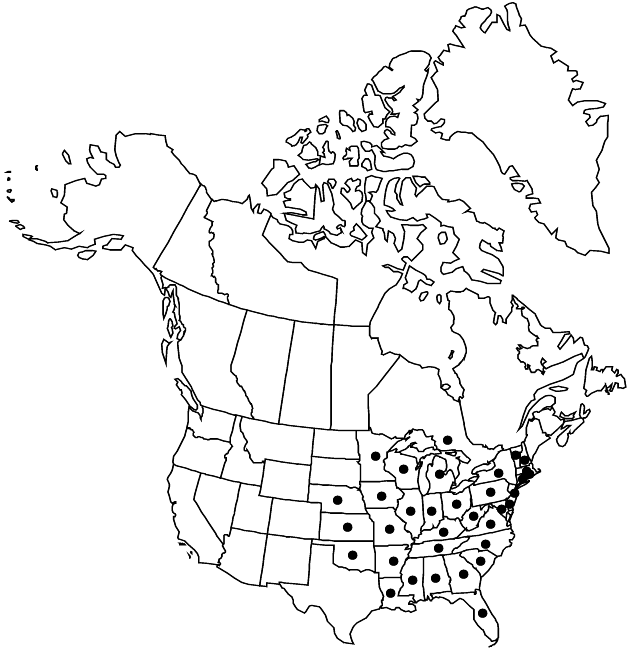Eutrochium purpureum
Sida 21: 902. 2004.
Plants 30–200 cm. Stems usually dark purple at nodes, usually otherwise greenish, rarely purplish green, usually solid, rarely ± hollow near bases, glabrous proximally, ± glandular-puberulent distally and among heads. Leaves mostly in 3s–4s (–5s); petioles 5–15 (–20) mm, glabrous or sparingly puberulent, rarely ciliate; blades pinnately veined, lanceovate or ovate to deltate-ovate, mostly (7–) 9–26 (–30) × (2.5–) 3–15 (–18) cm, bases abruptly or gradually tapered, margins coarsely serrate, abaxial faces sparingly and minutely glanddotted and densely pubescent to glabrate, adaxial faces sparingly puberulent and glabrescent or glabrous. Heads in loose, convex, compound corymbiform arrays. Involucres often purplish, 6.5–9 × 2.5–5 mm. Phyllaries usually glabrous, sometimes sparsely hairy. Florets (4–) 5–7 (–8); corollas usually pale pinkish or purplish, 4.5–7 mm. Cypselae 3–4.5 mm.
Distribution

Ont., Ala., Ark., Conn., Del., Fla., Ga., Ill., Ind., Iowa, Kans., Ky., La., Mass., Md., Mich., Minn., Miss., Mo., N.C., N.H., N.J., N.Y., Nebr., Ohio, Okla., Pa., R.I., S.C., Tenn., Va., Vt., W.Va., Wis.
Discussion
Varieties 2 (2 in the flora).
Eutrochium purpureum is morphologically variable and is known to hybridize with all other species in the genus (E. E. Lamont 1995). Historically, more than a dozen infraspecific taxa have been recognized; the extent of intergradation and the lack of correlation among varying traits tend to make recognition of more than two varieties impractical.
Selected References
None.
Key
| 1 | Leaves: abaxial faces usually glabrous, sometimes sparsely to densely hairy along major veins (hairs fine, simple, 1-cellular); s New Hampshire to n Florida, w to se Minnesota, Iowa, and e Oklahoma | Eutrochium purpureum var. purpureum |
| 1 | Leaves: abaxial faces densely and persistently puberulent to villous; s Minnesota, Iowa, and ne Kansas to s Wisconsin, n Illinois, and n Missouri | Eutrochium purpureum var. holzingeri |
"fine" is not a number.